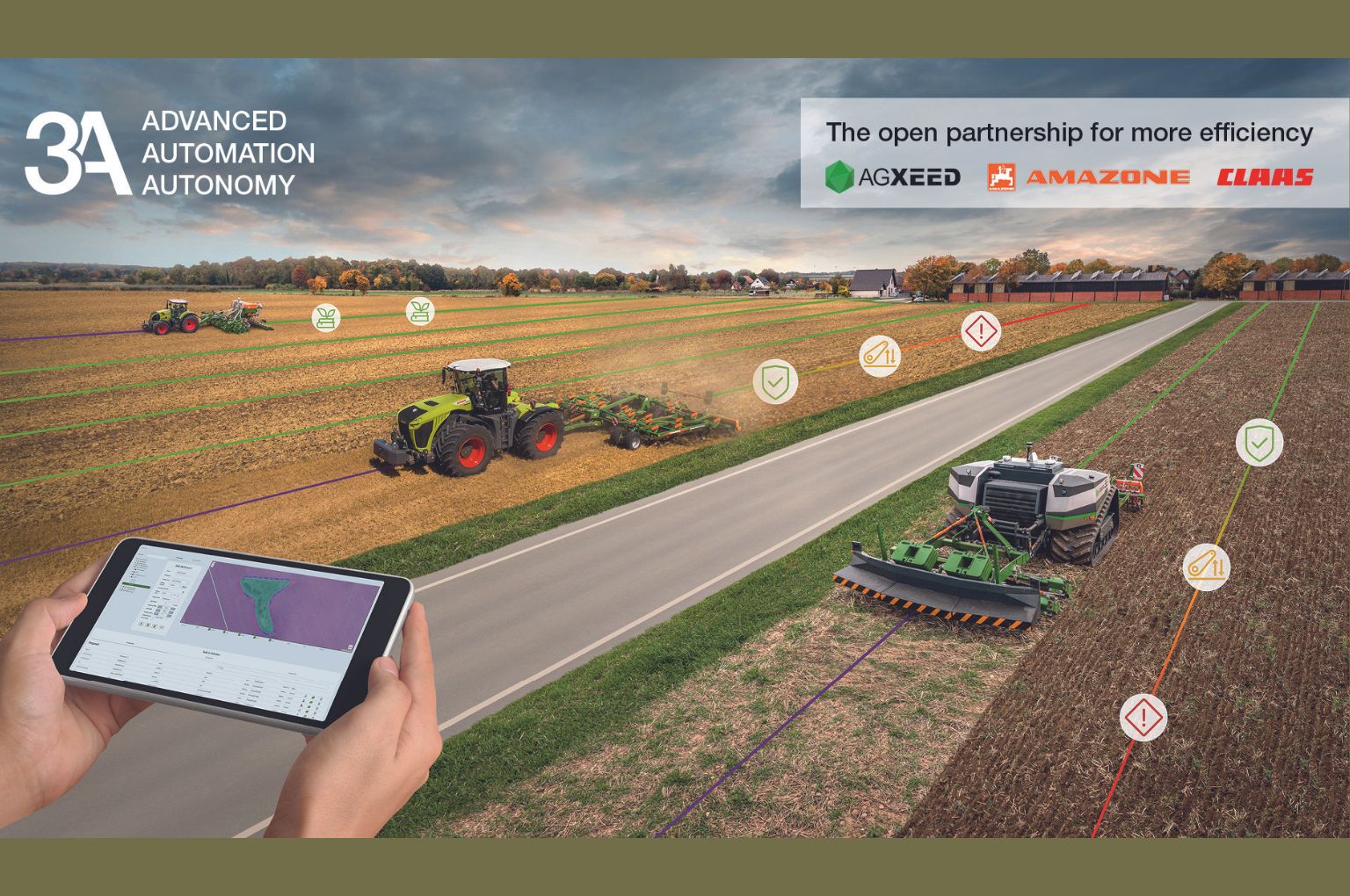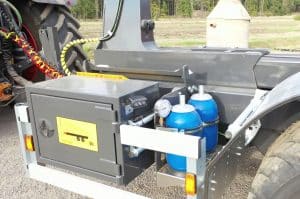Claas, AgXeed and Amazone have stepped up their collaboration in the field of highly automated and autonomous agricultural machinery and work processes by establishing the first multi-manufacturer autonomy group. 3A , ADVANCED AUTOMATION & AUTONOMY aims to accelerate the development, standardisation and market introduction of semi- and fully autonomous tractor-implement combinations through their combined expertise and is open to other agricultural machinery manufacturers.
In many regions of the world, a shortage of skilled labour is a major factor driving the development of highly automated and autonomous technologies in industry and agriculture. The aim is not to replace skilled workers, but to free them up for more demanding tasks, especially at peak times. The 2023 grain harvest in central and northern Europe is a good example: threshing, stubble working, primary tillage and drilling cover crops and follow-on crops all had to be performed simultaneously due to weather-related harvest delays, at a time when skilled workers were often unavailable. New technologies can manage these peaks and make it possible in future to achieve optimum results even with less experienced staff.
However, the further automation of agricultural processes calls for even closer collaboration between manufacturers of tractors and carrier vehicles on the one hand and implements on the other. In recognition of this, Claas, AgXeed and Amazone have joined forces to establish 3A – ADVANCED AUTOMATION & AUTONOMY. The three partners have been working together in the field of autonomy for some time already – Claas and Amazone are minority shareholders in the Dutch company AgXeed. Through the establishment of 3A, the companies will more closely integrate their individual areas of expertise and create further partnerships to enable the developed technologies to be rolled out more rapidly and on a broader basis.
Initial solutions for agricultural practice
The market-ready technology developed by the 3A group comprises design and implementation software which was previously available only for autonomous field robots, but can now be used in conjunction with the AgXeed box to control tractors and implements as well. Depending on the requirements and the available hardware, the level of control can range from highly automated to autonomous. From planning through to implementation and analysis, the technology eases the workload of both farm managers and operators and increases the efficiency of agricultural processes.
“Agricultural robots currently act mainly in closed systems with limited applications and without the option of being able to use them in parallel or in combination with other vehicles and implements,” the development team explains. “And this is where 3A’s innovative approach comes in: within the group, we have developed the AgXeed box technology, which for the first time connects tractors and implements to the planning and autonomous implementation process using the standardised ISOBUS interface. Via this interface, implements can interact with field robots, AgBots and tractors to enable automated or autonomous process optimisation.”
The first products developed by 3A are the Amazone AutoTill for mulch cultivators and Claas Autonomy connect, which incorporates the entire tillage planning and implementation process. These solutions, which have been tested under field conditions, are the starting point for further multi-manufacturer applications involving every conceivable machine combination for outdoor work processes.
Planning ahead with real-life machine parameters
In addition to A-B lines and A-B contours for automatic steering, and route optimisation, work orders for tractors nowadays may include an application map. 3A goes one step further and enables preliminary planning specifically engineered for process optimisation. This includes the start and end point of application, headland turns and site-specific implement control. Planning ahead with real-life machine parameters – for example rear linkage and hydraulic functions for adjusting the working depth and intensity – makes it possible to program dynamic adjustments to the machine combination before implementation in order to achieve the desired quality of work. Up until now, closed systems have included neither planning nor supervision of the implements and the subsequent implementation process, with the exception of application rates. But with Autonomy connect, CLAAS tractors in conjunction with implements can perform fieldwork with a high degree of automation, or even autonomously. Depending on the degree of automation, the operator can perform other tasks from the cab, or even in the field or yard. Tasks are planned in the familiar CLAAS farm management information system (FMIS) or the AgXeed portal, where it has long been possible to schedule tracks and application maps for tasks.
Up to now, approaches to tillage automation have been limited to comfort functions. Autotill for Amazone cultivators continuously compares the tillage operating procedure with data from the tractors, thereby taking responsibility for the operator’s supervisory tasks.
Claas Autonomy connect, Amazone AutoTill and AgXeed AgBot offer significant advantages:
- Both the tractor and the implement perform all operations precisely as the farmer or contractor has planned.
- The planning function not only calculates the best possible route; it also ensures that the tractor-implement combination is optimally configured. This prevents poor quality work and inefficiency resulting from incorrect settings.
- The first plan forms the basis for reducing the workload in subsequent years, as only seasonal adjustments are then required – for example, depending on the main crop, follow-on crop and rotation.
- Errors by the machine combination are detected by sensors and automatically corrected to maintain consistently high process quality. For example, the system automatically detects when the cultivator is at risk of clogging and adjusts the working depth and speed accordingly.
- Responsibility for producing optimum results no longer lies solely with the operator, which reduces the pressure on them, especially during long working days.
- Preplanned and process-optimised machine-implement combinations are more energy efficient and thus more cost-effective to operate.
- Farmers and highly qualified operators can perform other more important operational tasks while the planned task is being performed, since constant supervision is no longer needed.
- On non-autonomous tractors, the technology also enables less skilled or experienced operators to produce optimal results.
Talks are currently underway with other machine manufacturers who are interested in joining the multi-manufacturer group and thus play an active role in expanding the range of applications.









